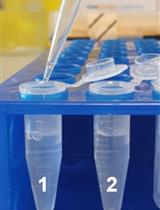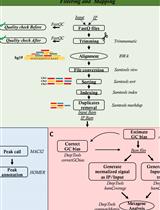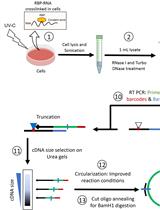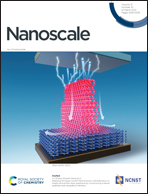- EN - English
- CN - 中文
A High-throughput Pipeline to Determine DNA and Nucleosome Conformations by AFM Imaging
通过 AFM 成像确定 DNA 和核小体构象的高通量流程
发布: 2021年10月05日第11卷第19期 DOI: 10.21769/BioProtoc.4180 浏览次数: 3159
评审: Steven BoeynaemsAmberley D. StephensAnonymous reviewer(s)

相关实验方案

HaloChIP-seq用于体内小鼠转录因子 Cistromes 的抗体独立映射
Ann Louise Hunter [...] David A. Bechtold
2022年07月05日 3980 阅读

利用OxiDIP-Seq方法对含8-氧代-2′-脱氧鸟苷的受损DNA进行全基因组图谱分析
Francesca Gorini [...] Stefano Amente
2022年11月05日 2784 阅读

用于在活细胞中以单个核苷酸分辨率分析RNA-蛋白质相互作用位点的修订iCLIP-seq方案
Syed Nabeel-Shah and Jack F. Greenblatt
2023年06月05日 5107 阅读
Abstract
Atomic force microscopy (AFM) is a powerful tool to image macromolecular complexes with nanometer resolution and exquisite single-molecule sensitivity. While AFM imaging is well-established to investigate DNA and nucleoprotein complexes, AFM studies are often limited by small datasets and manual image analysis that is slow and prone to user bias. Recently, we have shown that a combination of large scale AFM imaging and automated image analysis of nucleosomes can overcome these previous limitations of AFM nucleoprotein studies. Using our high-throughput imaging and analysis pipeline, we have resolved nucleosome wrapping intermediates with five base pair resolution and revealed how distinct nucleosome variants and environmental conditions affect the unwrapping pathways of nucleosomal DNA. Here, we provide a detailed protocol of our workflow to analyze DNA and nucleosome conformations focusing on practical aspects and experimental parameters. We expect our protocol to drastically enhance AFM analyses of DNA and nucleosomes and to be readily adaptable to a wide variety of other protein and protein-nucleic acid complexes.
Keywords: Atomic force microscopy (原子力显微镜)Background
Nucleosomes are the basic units of compaction of eukaryotic DNA into chromatin and function as regulators of gene readout and activity (Bowman and Poirier, 2015; Sadakierska-Chudy and Filip, 2015; Baldi et al., 2020). Canonical nucleosome core particles consist of two copies each of the four histones H2A, H2B, H3, and H4 assembled into a histone octamer that is tightly wrapped by 147 bp of DNA (Luger et al., 1997; Richmond and Davey, 2003). Accessibility to the genetic code for readout and processing is facilitated by (partial) unwrapping of nucleosomal DNA and can be achieved either by active processes involving, e.g., RNA polymerase or nucleosome chaperones that exert forces and torques on the nucleosomes (Sirinakis et al., 2011; Mueller-Planitz et al., 2013; Narlikar et al., 2013; Ordu et al., 2016), or spontaneously by thermal fluctuations (Li and Widom, 2004). Using single-molecule micromanipulation techniques such as optical tweezers, the energetics of force-induced nucleosome unwrapping has been probed at high resolution (Mihardja et al., 2006; Hall et al., 2009; Schlingman et al., 2014; Ngo et al., 2015; Kaczmarczyk et al., 2020). However, the unwrapping landscape in the absence of force has been more difficult to access.
Atomic force microscopy (AFM) is a powerful tool to probe nucleosome structure and interactions due to its capability to image molecular complexes at the single-molecule level, label-free, and with sub-nanometer resolution, well suited to visualize the DNA and protein components of nucleosomes (Shlyakhtenko et al., 2009; Bintu et al., 2011; Miyagi et al., 2011; Katan et al., 2015; Ordu et al., 2016). Recent improvements in hardware make fast imaging of thousands of molecules possible, and combination with automated image analysis enables highly quantitative and reproducible studies of DNA and nucleoprotein complexes (Dufrêne et al., 2017; Ando, 2018; Brouns et al., 2018; Würtz et al., 2019; Bangalore et al., 2020).
By combining large field of view AFM imaging and automated image analysis of DNA and nucleosomes, we have recently elucidated the nucleosomal wrapping landscape for passive invasion of nucleosomes with linker DNA, in contrast to the previous force-induced unwrapping assays (Konrad et al., 2021). While we have demonstrated the strength of our methodology by quantitatively capturing the conformational ensemble of wild-type and CENP-A nucleosomes – centromeric nucleosomes where histone H3 is replaced with the CENP-A variant – the methodology can be easily adapted to study a wide range of open questions such as the effect of post-translational modifications on nucleosome wrapping or the impact of DNA sequence on nucleosome positioning on the single-molecule level.
The current protocol describes all steps necessary to study DNA and nucleosomes by AFM imaging, starting with the surface deposition of the molecules and ending with the quantitative image analysis after AFM imaging. The protocol describes AFM imaging of dry samples in air. However, it can be readily adapted for AFM measurements in liquid. In liquid, the deposition protocol and imaging parameters have to be adjusted. In particular, instead of drying the surface after depositing the sample, the sample buffer solution remains on the surface for imaging. Examples of how to perform liquid AFM measurements have been published previously (Bussiek et al., 2003; Brouns et al., 2018). Subsequent analysis of the AFM images might also require adjustment of the image analysis parameters (see AFM image analysis).
Materials and Reagents
For surface deposition of the sample
Mica Grade V-1 25 mm discs (SPI Supplies, catalog number: 01926-MB)
Marking tape ROTI (Carl Roth, catalog number: 8000.1)
50 ml irrigation syringes (Braun, catalog number: 4617509F)
Parafilm (Carl Roth, catalog number: H666.1)
Protein LoBind Tubes 0.5 ml (Eppendorf, catalog number: 0030108094)
Petri dishes (Carl Roth, catalog number: 0690.1)
Kimwipes (Kimtech, catalog number: 5511)
Milli-Q H2O (Merck, catalog number: Z00Q0V0WW)
Poly-L-lysine (Sigma Aldrich, catalog number: P0879 – diluted to 0.01% in Milli-Q H2O)
N2 gas (to blow dry the surface)
DNA/nucleosome sample – prepared as described previously (Krietenstein et al., 2012)
Ethanol (Carl Roth, catalog number: T171.4 – diluted to 80% with Milli-Q water)
Deposition buffer (see Recipes)
For AFM imaging
Glass slides (Thermo Scientific Menzel, catalog number: 15998086)
Double-sided adhesive discs (SPI Supplies, catalog number: 05095-AB)
Equipment
Self-closing tweezers (SPI Supplies, catalog number: SN5AP-XD)
Vortex mixer (Scientific Industries, catalog number: SU-0236)
Centrifuge (to fit 0.5 ml Eppendorf tubes and spin down tube content; Carl Roth, catalog number: T464.1)
Tweezers ESD-safe (SPI Supplies, catalog number: 0CFT07PE-XD)
AFM cantilevers for high-speed imaging in air; we used FASTSCAN-A (resonance frequency 1400 kHz, spring constant 18 N/m; Bruker) or AC160TS (200-400 kHz, 26 N/m; Olympus) cantilevers
Imaging AFM; we employed a Nanowizard Ultra Speed 2 (Bruker) and a MultiMode 8 (Bruker)
Software
Software to plane-correct the raw AFM data (see section “AFM image analysis”)
Microsoft Excel
Python 3
Software toolbox to analyze DNA and nucleosomes in AFM images (previously described in Konrad et al., 2021), and available for download at https://github.com/SKonrad-Science/AFM_nucleoprotein_readout)
Procedure
文章信息
版权信息
© 2021 The Authors; exclusive licensee Bio-protocol LLC.
如何引用
Konrad, S. F., Vanderlinden, W. and Lipfert, J. (2021). A High-throughput Pipeline to Determine DNA and Nucleosome Conformations by AFM Imaging. Bio-protocol 11(19): e4180. DOI: 10.21769/BioProtoc.4180.
分类
分子生物学 > DNA > DNA-蛋白质相互作用
生物物理学 > 显微技术 > 原子力显微镜
分子生物学 > DNA > 染色质可接近性
您对这篇实验方法有问题吗?
在此处发布您的问题,我们将邀请本文作者来回答。同时,我们会将您的问题发布到Bio-protocol Exchange,以便寻求社区成员的帮助。
Share
Bluesky
X
Copy link









